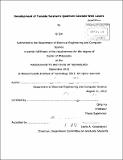Development of tunable terahertz quantum cascade wire lasers
Author(s)
Qin, Qi, Ph. D. Massachusetts Institute of Technology
DownloadFull printable version (37.96Mb)
Other Contributors
Massachusetts Institute of Technology. Department of Electrical Engineering and Computer Science.
Advisor
Qing Hu.
Terms of use
Metadata
Show full item recordAbstract
For a long time, terahertz (THz) radiation has been of great interest to scientific community because of its spectroscopic and imaging applications based on its unique properties, such as the capabilities to penetrate many materials which are opaque in other frequency range (e.g. packaging, plastics, paints and semiconductors), and spectroscopic signatures of many important materials. In this thesis, a continuously tunable THz wire QC laser, which comprises a QC laser with deep sub-wavelength transverse dimensions, and a movable side object, termed as "plunger", is demonstrated. This deep sub-wavelength cross-section results in a large fraction of mode propagating outside of the laser core (GaAs/A1₀.₁₅Ga₀.₈₅As material system). The frequency tuning is achieved by changing the transverse wave vector, using a plunger made by metal (metal plunger) or silicon (dielectric plunger). When nudged close to the wire laser core, the metal plunger can push modes to the opposite side of the waveguide. Confined by a metal-metal waveguide, the mode is squeezed and the transverse wave vector is increased, resulting in a blue-shifted frequency. In contrast, a silicon plunger can suck the mode out due to its similar refractive index to GaAs/Al₀.₁₅Ga₀.₈₅As material system of laser core. Thus a decreased transverse wave vector results in a redshifted frequency. Although a tuning record of 138GHz (3.6%) was achieved, a discontinuous tuning resulted from a jittering movement of the plungers due to its friction with the guiding system. To solve this problem, an improved plunger based on micro-mechanical system (MEMS) was implemented. This MEMS plunger uses a two-stage folded-beam flexure to isolate the misaligned external actuation. The plunger is attached with the flexure which suspends above a silicon substrate to eliminate friction. Eventually, this MEMS flexure was actuated by a mechanical system which comprised a lever to de-amplify the displacement of a linear mechanical feedthrough. This MEMS plunger enabled a restorable and frictionless movement which led to a continuous tuning range of 330GHz (8.6%) centered at ~3.85 THz. The challenges posted by the weak mode discrimination led to the development of comb-shape connectors which electrically connect the top metal of wire lasers and the side bonding pad. This design can significantly increase the mode discrimination by selectively guiding undesired mode into the lossy bonding pad. This robust design of single mode operation enables the initial lasing at a frequency far below the gain peak, which can potentially increase the tuning range significantly.
Description
Thesis (Ph. D.)--Massachusetts Institute of Technology, Dept. of Electrical Engineering and Computer Science, 2012. Cataloged from PDF version of thesis. Includes bibliographical references (p. 179-188).
Date issued
2012Department
Massachusetts Institute of Technology. Department of Electrical Engineering and Computer SciencePublisher
Massachusetts Institute of Technology
Keywords
Electrical Engineering and Computer Science.